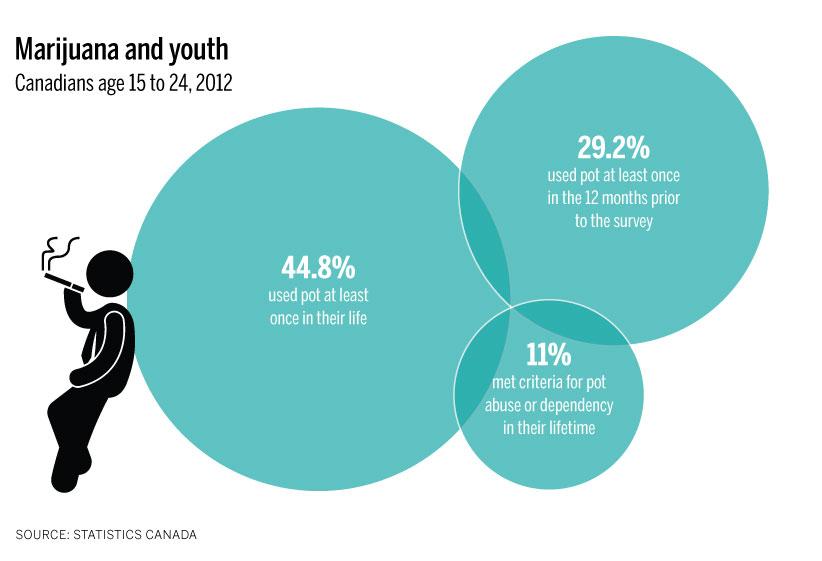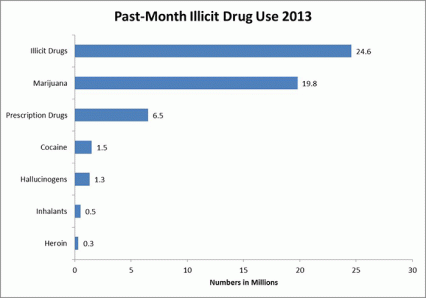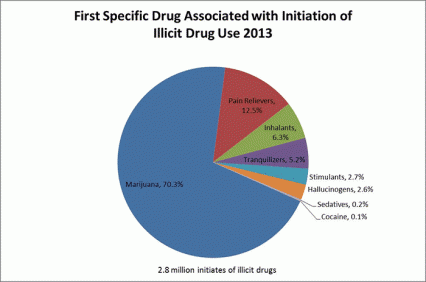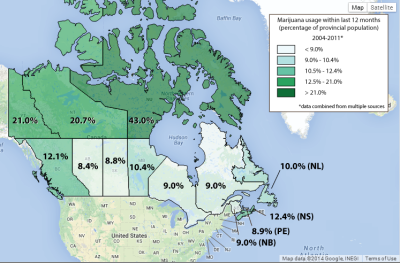Table of Contents
Introduction
Marijuana is popularly known as weed, Mary Jane, pot, bang or ganja. It’s mainly the shredded leaves and flowers of a plant called Cannabis Sativa. Some people smoke Marijuana in hand rolled cigarette called “joint” while others smoke it through pipes. The main mind-altering (psychoactive) agent in Marijuana is called “delta- 9- tetrahydrocannabinol” (THC). The chemical is found in most plant resin. The resin can be used both recreationally and medically.

The history of Marijuana
Marijuana is an agent that has been used to achieve euphoria for over 3000 years (Narconon, 2016). The earliest description of weed dates back to 2737 B.C this is from the Chinese medical reference. From that time the drug slowly grew in popularity and spread from China to India, to North Africa until it reached Europe in early 500 A. D. The first direct reference to the psychoactive agent of Cannabis dates to Chinese emperor Shen Nung in 2737 B.C. The Chinese used it for its power as a medication. They used to treat malaria, gout, rheumatism and absent-mindedness. At that time the early Chinese people knew the drug was made of intoxicating properties, but the medicinal value outweighed its adverse effects at that point. 200 years later the Indian people started using the drug, but unlike the Chinese, they used it for recreational purposes. Later on, Muslims made the drug popular in Persia (Iran) and North Africa through a street name called hashish. Marijuana spread across Europe where it was mainly grown as a crop (Narconon, 2016). In 1611, marijuana was introduced to the new world where it was grown as a crop alongside tobacco. At that time Americans used it as a source of fiber only. In the early 90s Marijuana began to be used as a recreational agent. It was employed in teas, at clubs and gained popularity among the main cities in America.
The United States Pharmacopeia listed Marijuana from 1850 to 1942 and was recommended for use in treating labor pains, rheumatism, and nausea (Narconon, 2016). It was not until the late 1950s did the Bureau of Narcotics and Dangerous Drugs started listing Marijuana as a powerfully addictive substance. Its popularity grew from 1960 to 1980. It was used by college students, hippies and the beat generation as a symbol of rebellion against authority. Marijuana grew to have a high abuse potential and no accepted medical use through the 70s and 80s. After the establishment of the Controlled Substance Act in 1970, Marijuana crops had stopped being grown in America. This left room for Mexico and Colombia to grow and become the primary supplier of Marijuana across America and Canada. Cannabis traveled through various regions of the world. It traveled through Africa, then Europe, then to South Africa until it eventually reached North American and Canada in the 19th century.
We can do it today.
Statistics about Marijuana
According to the United States, more than 158.8 million people use Marijuana around the world. The number represents more than 3.8% of the earth’s human population. In 2008, the National Survey on Drug Use and Health (NSDUH) estimated that 2.1 million people abused Marijuana for the first time that year. Among people aged 12- 17 years old, 6.7% were marijuana users in 2008. Statistics from the Drug Enforcement Agencies (DEA) showed that domestic Marijuana (U.S) production had increased by 2.2 million pounds in from 2006 to 2015. Furthermore, 58% of people aged between 12- 17years have stated that Marijuana was easy to get around their neighborhood (NIDA, 2016). In 2010, there were over 300,000 reported cases of Marijuana in United States hospitals. The Drug Enforcement Agency also reported that a large percentage of people reported for crimes tested positive for marijuana. On the people arrested 45% of those who tested positive were males. The DEA also reported that alcohol, marijuana was the second most frequently abused substance (NIDA, 2016).
In Canada, marijuana stands as the most used illegal drug in the country. Almost half of all Canadians (44%) claim they have used Marijuana one time in their life (Ottawa, 2008). The use of Marijuana varies across Canada. Teenagers at Toronto are less likely to use weed 20% as compared to those in the north (33%) or the West (29%). Further, statistics also show that more than 3% of 7th graders have used Marijuana in the past one year. Compared to students in other developed countries Canadian students have the highest rate of past year Marijuana use at 28% in (2009- 2010) (CCSA, 2017). According to the Canadian Centers of Substance Abuse, more than 10% of all Marijuana users in Canada tend to develop dependency. Also, the number of reported Marijuana offenses grew from 35,000 in 1999 to over 400,000 arrest in 2010.


| Prevalence of Marijuana/Hashish for 8th Graders, 10th Graders and 12th Graders | ||||
| Drug | Time Period | 8th Graders | 10th Graders | 12th Graders |
| Marijuana/Hashish | Life Time | 12.8 | 29.70 | 44.50 |
| Past Year | 9.4 | 23.90 | 35.60 | |
| Past Month | 5.4 | 14.00 | 22.50 | |
| Daily | 0.70 | 2.50 | 6.00 | |
Prevalence of Marijuana/Hashish for 8th Graders, 10th Graders and 12th Graders.
| Prevalence of Marijuana for Ages 12 or Older, Ages 12 to 17, Ages 18 to 25 and Ages 26 or Older | |||||
| Drug | Time/Period | Ages 12 or Older | Ages 12 to 17 | Ages 18 to 25 | Ages 26 or older |
| Marijuana/Hashish | Life Time | 44.00 | 15.70 | 52.70 | 46.00 |
| Past year | 13.50 | 12.60 | 32.20 | 10.40 | |
| Past Month | 8.30 | 7.00 | 19.80 | 6.50 | |
Prevalence of Marijuana for Ages 12 or Older, Ages 12 to 17, Ages 18 to 25 and Ages 26 or Older.
Further, statistics show that the abuse of Marijuana has grown by 1.57% from 2007 to 2012. In 2013 19.8 million people were abusing Marijuana in the United States this is 1.7% more compared with the number of individuals abusing the drug in 2007 (14.5 million people).

Illicit drug use in 2013.
Marijuana is also considered as the initiation drug among people who are aged 13yrs and older.

Marijuana accounts for 67% of treatment admission for substance abuse for people aged 13yrs and older: of the people who are treated two out of the given six would become addicted to the drug in the long run (Langlois, 2012).

Thesis/Argument
There are no cases of Marijuana overdose that led to death; this has led people to believe that it’s not harmful. Furthermore, many experts such as Mark Kleiman (drug policy expert at New York University) have come out saying that Marijuana remains safe unless it’s abused. All this has led people to believe that Marijuana is a safe drug to use. However, many people tend to fall into the habit of using Marijuana frequently, and this is what starts the addiction and renders Marijuana use harmful.
Pot is Harmless (Doesn’t lead to death)
The notion that marijuana is harmless unless it has been abused is a popular idea that has resulted in an increase of addicts (Abuse, 2007). Through an investigation that was done by the National Academies of Science, Engineering, and Medicines. The research pointed out that Marijuana had many adverse effects such as psychosis and schizophrenia. However, it did not cause the common issues which are linked to tobacco. Most notably, lung cancer, throat cancer, and other diseases. That research which was released in 2013 fed to Marijuana users the notion that Marijuana is a safe drug to use. Moreover, the study also showed that Marijuana carried with it a couple of benefits. It included: – relief of chronic pain, vomiting, nausea and reducing the effects of conditions such as epilepsy (Abuse, 2007). This benefits together with the little adverse effects have led many people to believe that Marijuana is a safe drug to use.
Leading to Harder Drug Use
Marijuana users have also defended their habits through claiming that the use of Marijuana doesn’t lead to the use of harder drug use. Marijuana users have argued that the drug doesn’t result in the use of hard drugs such as cocaine and heroin. The correlation between Marijuana and other hard drugs is slightly lower compared to the correlation between other drugs and hard drugs.
Increase creativity
Marijuana users also think the use of Marijuana causes an increase in creativity. A case study done on 2012 by Consciousness and Cognition stated that the use of Marijuana increases the creativity of people especially when it came to the use of language. It was discovered that Cannabis increase verbal fluency on people with low creativity to the same level as those people with high creativity (Holder, 2014). The increase in verbal fluency can be seen in mostly musicians and actors. Some of the famous musicians and actors who have claimed to have used Marijuana are – Madonna, Robert Downey Jr, Johnny Depp, Matt Damon, and Jennifer Aniston among others. All of them have come out and claimed that Marijuana boosts their performance in their day to day job. This claims and assumptions have led people to believe that Marijuana is a safe drug.
It’s organic
Marijuana is naturally grown hence its organic. It contains an organic compound called “delta- 9- tetrahydrocannabinol” (THC). Which causes alteration to the mind hence caused addiction. However, many people have gone ahead and claimed Marijuana is a safe drug because they can grow it in their homes, schools or their farm. The direct relation between Marijuana and the sellers/users has given users more trust to think that the drug is safe
Discussion (Facts)
Marijuana leads to doing different disorders
The NIDA reports that more than 86% of Marijuana users believe that using the drugs is safe because it doesn’t result in any death. But is the drug safe to use? Marijuana use can result in the development of many different problems. Past researchers have shown that continuous use of Marijuana leads to the development of Marijuana Use Disorder (M.U.D) is what is known as Marijuana addiction (Armand, 2016). After an extensive use of the drug Marijuana users become addicted to the drug. Anytime a user tries to stop using Marijuana; the body will automatically go into withdrawal stage. The withdrawal symptoms of Marijuana are moods, irritability and sleep difficulties. Once addicted, a person cannot stop using the drug, although it affects his/her day to day life. Hence Marijuana doesn’t lead to death but brews long life troubles for a person, including chronic illness.

Marijuana kills creativity (IQ)
The National Institute on Drug Abuse reported that continuous use of Marijuana reduces the IQ of a person. Marijuana causes the brain to adapt to significant amounts of its active compound; this causes the brain to lessen the production of sensitivity to its endocannabinoid neurotransmitter (NIDA, 2016). A reduction in the manufacture of this important hormone leads to a decrease in the thinking power of the brain. The drug also has severe effects on the visuospatial memory of a person. In other words, Marijuana users often start to lose their visual memory. The loss of visual map has led long-time users of Marijuana to often loose direction, and get amentia. Marijuana can stimulate the brain in the short term, but in the long term, it interferes with the working of the brain and cuts short its life span (Armand, 2016).
Marijuana is a gateway drug.
Another point of discussion is whether Marijuana leads people to start using hard drugs. Although the correlation between Marijuana and hard drugs is lower compared to other drugs, it doesn’t necessarily mean Marijuana doesn’t open the does for drug users to start using hard drugs. Even though many Marijuana users fail to believe it but Marijuana is considered as the no. 1 gateway drug in the world. One study used longitudinal data from the National Epidemiology Study of Alcohol Use and Related Disorder found that adults who used Marijuana for a long time developed alcohol disorder and substance abuse issues within the next three years. People who used Marijuana and had alcohol disorder at the onset of the study developed an even worse case of alcohol disorder at the end of the survey. These findings are consistent with the fact that Marijuana is a gateway drug. Many people who use Marijuana often become alcoholics and develop substance abuse problems.
Marijuana is organic and still dangerous.
The fact that Marijuana is natural doesn’t stop it from being unsafe. A lot of natural things are dangerous such as venom and some plants. According to researchers continuous use of weed makes a person less aware of their environment and leads to long creative thinking issues. Leading psychologist at Leiden University in Netherlands Mikael Kowal led an experiment that showed Marijuana causes the brain to work less efficiently (CAMH, 2006). High doses of Marijuana influences both the unconscious processing of the brain and later affects the more conscious stages of error processing. Whether Marijuana is organic or non- organic, it causes harmful effects on the human body rendering it unsafe.
Additional Information
From the facts highlighted it is definite that Marijuana does more harm to a person than good. However, medical practitioners sometimes use Marijuana in a form called “Medical Marijuana” to treat various types of ailment. Medical marijuana is the whole, unprocessed plan or necessary extracts to treat various forms of illness. However legally the United States Food and Drug Administration doesn’t recognize the use of Marijuana as a drug. The fact that Marijuana contains various forms of compounds that can cure illness has led many people to argue for it to be legal for medicine purpose. In fact, in the United States alone more than three states have legalized the use of Marijuana for Medical uses (Brown, 2016).
Conclusion
In conclusion, although people think that Marijuana is a safe drug to use, it does more harm to people than good. Marijuana causes negative social, physical and psychological effects to an individual. In small doses, Marijuana can be used to treat various conditions, but its long-term use can cause both severe and chronic conditions to a person. In current times, Marijuana should not be considered as a safe drug. It should continue to be considered the harmful drug that it is to save lives and to build the society.
We can do it today.
- Abuse, C. C. (2007). Substance Abuse in Canada: Youth Focus. Ottawa: CCSA.
- Armand, W. (2016, August 19). Havard Health. Retrieved from Havard Health Publications: http://www.health.harvard.edu/blog/the-health-effects-of-marijuana-from-recreational-and-medical-use-2016081910180
- Brown, C. (2016). Marijuana Research not reaching Canada’s toking teens. CBCnews, 112- 117.
- CAMH. (2006, July 18). Centre for Addiction and Mental Health. Retrieved from About Marijuana: http://www.camh.ca/en/hospital/health_information/a_z_mental_health_and_addiction_information/marijuana/Pages/about_marijuana.aspx
- Canada, H. (2012, March 23). Canadian Alcohol and Drug Use Monitoring Survey. Retrieved from Health Canada: http://www.hc-sc.gc.ca/hc-ps/drugs-drogues/stat/_2012/summary-sommaire-eng.php
- CCSA. (2017, Jan 23). Marijuana. Retrieved from Canadian Centre of Substance Abuse and Addiction: http://www.cclt.ca/Eng/Pages/default.aspx
- Holder, J. A. (2014). Marijuana Use and Well- Being in University Students. Vancouver: University of British Columbia.
- Langlois, M. R. (2012, February 20). Prevalance and Correlates of Marijuana use in Canada, 2012. Retrieved from Statistics Canada: http://www.statcan.gc.ca/pub/82-003-x/2015004/article/14158-eng.htm
- Narconon. (2016, July 14). Narconon.org. Retrieved from History of Marijuana: http://www.narconon.org/drug-information/marijuana-history.html
- NIDA. (2016, June 26). Marijuana. Retrieved from National Institute on Drug Abuse: https://www.drugabuse.gov/drugs-abuse/marijuana
- Press, U. (2008, Febuary 24). Marijuana in Canada. Retrieved from Society the Individual: https://www.med.uottawa.ca/sim/data/Marijuana_e.htm

